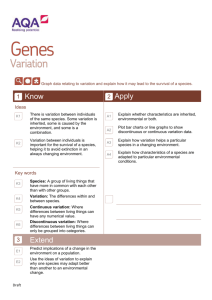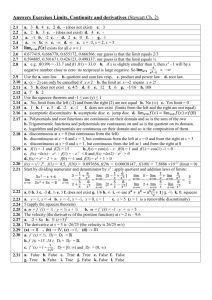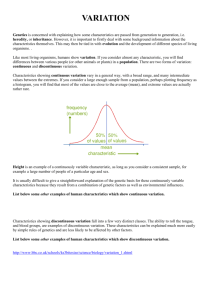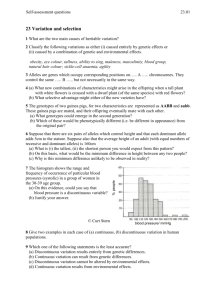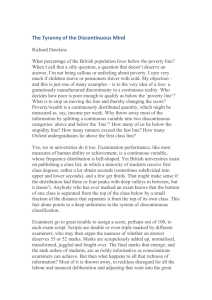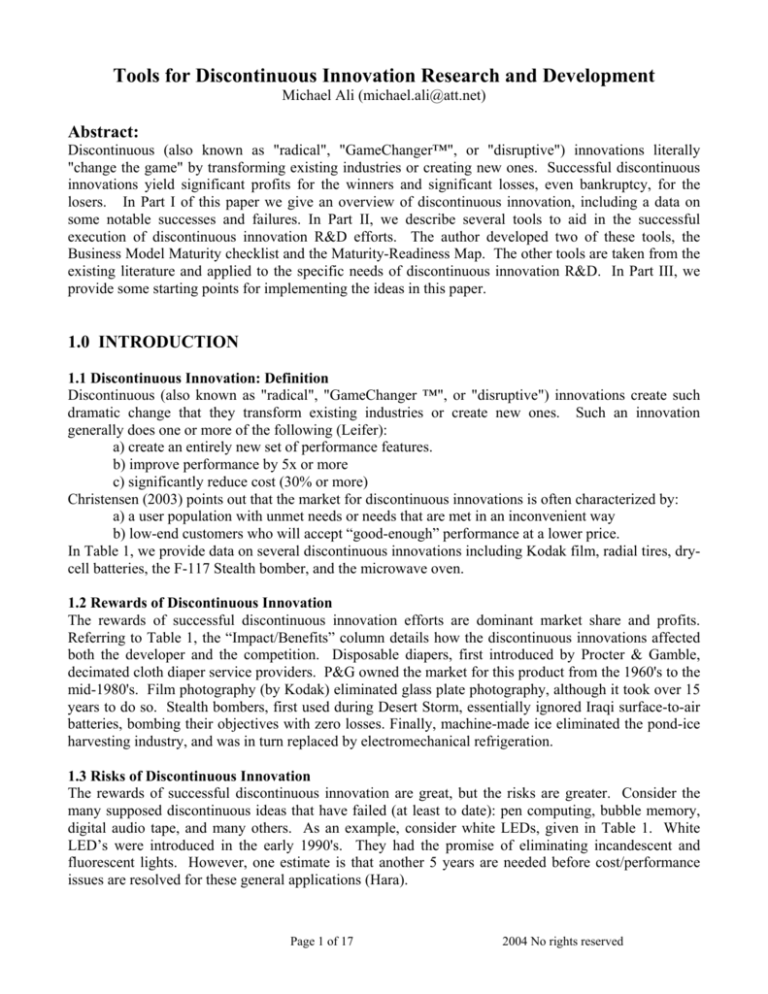
Tools for Discontinuous Innovation Research and Development
Michael Ali (michael.ali@att.net)
Abstract:
Discontinuous (also known as "radical", "GameChanger™", or "disruptive") innovations literally
"change the game" by transforming existing industries or creating new ones. Successful discontinuous
innovations yield significant profits for the winners and significant losses, even bankruptcy, for the
losers. In Part I of this paper we give an overview of discontinuous innovation, including a data on
some notable successes and failures. In Part II, we describe several tools to aid in the successful
execution of discontinuous innovation R&D efforts. The author developed two of these tools, the
Business Model Maturity checklist and the Maturity-Readiness Map. The other tools are taken from the
existing literature and applied to the specific needs of discontinuous innovation R&D. In Part III, we
provide some starting points for implementing the ideas in this paper.
1.0 INTRODUCTION
1.1 Discontinuous Innovation: Definition
Discontinuous (also known as "radical", "GameChanger ™", or "disruptive") innovations create such
dramatic change that they transform existing industries or create new ones. Such an innovation
generally does one or more of the following (Leifer):
a) create an entirely new set of performance features.
b) improve performance by 5x or more
c) significantly reduce cost (30% or more)
Christensen (2003) points out that the market for discontinuous innovations is often characterized by:
a) a user population with unmet needs or needs that are met in an inconvenient way
b) low-end customers who will accept “good-enough” performance at a lower price.
In Table 1, we provide data on several discontinuous innovations including Kodak film, radial tires, drycell batteries, the F-117 Stealth bomber, and the microwave oven.
1.2 Rewards of Discontinuous Innovation
The rewards of successful discontinuous innovation efforts are dominant market share and profits.
Referring to Table 1, the “Impact/Benefits” column details how the discontinuous innovations affected
both the developer and the competition. Disposable diapers, first introduced by Procter & Gamble,
decimated cloth diaper service providers. P&G owned the market for this product from the 1960's to the
mid-1980's. Film photography (by Kodak) eliminated glass plate photography, although it took over 15
years to do so. Stealth bombers, first used during Desert Storm, essentially ignored Iraqi surface-to-air
batteries, bombing their objectives with zero losses. Finally, machine-made ice eliminated the pond-ice
harvesting industry, and was in turn replaced by electromechanical refrigeration.
1.3 Risks of Discontinuous Innovation
The rewards of successful discontinuous innovation are great, but the risks are greater. Consider the
many supposed discontinuous ideas that have failed (at least to date): pen computing, bubble memory,
digital audio tape, and many others. As an example, consider white LEDs, given in Table 1. White
LED’s were introduced in the early 1990's. They had the promise of eliminating incandescent and
fluorescent lights. However, one estimate is that another 5 years are needed before cost/performance
issues are resolved for these general applications (Hara).
Page 1 of 17
2004 No rights reserved
There are a number risks associated with discontinuous innovation:
• Misleading customer input: Clayton Christensen (1997 & 2003) provides several examples
where companies focused on meeting customer needs ignored the discontinuous innovations
that put them out of business. The story of radial tires (see Table 1), fits this pattern (Gale).
Uniroyal and Firestone ignored the threat of radial tires, developed by Michelin, because the
U.S. automakers did not want them. When the market finally recognized the superior
characteristics of radial tires, neither manufacturer was able to compete. Michelin bought
Uniroyal, and Bridgestone bought Firestone. Zangwill (1993) lists other ways that customer
input can be misleading:
- customers cannot express what they want
- customers may not know enough to be helpful
- customers may not identify a problem if they believe no solution is available for it
- customer wants may change by the time the product is available
- many people may be involved in the purchase, each with different requirements.
• The market is not known: The “killer application” (i.e., the application that drove demand)
for dry cell batteries was the flashlight, which did not exist when dry cell batteries were first
developed. Recognition of this market led the National Carbon Company to buy the Ever
Ready flashlight company and adopt the name “EverReady” for its batteries (Woehbler).
• Years of investment may be required: Xerox estimates an average of 8 years before
breakeven on any innovation projects, not including the time and money spent in the R&D
phase (Wolpert). Other sources list the lead-time for "new knowledge" innovations as 50
years (Drucker, Mhatre). Referring to the “Time(s)” column in Table 1, note that in several
cases (film photography, microwave oven, radial tires), the time between initial concept and
market success was decades.
• Inadequate supply chain: Hoover had no luck with selling vacuum cleaners until he created
his famous door-to-door sales force (Gershman). Polysack had to train clerks to use their
plastic grocery bags (Gale). Discontinuous innovations can change the game across the
supply chain, but the supply chain may not be ready to have the game changed.
Discontinuous development is therefore inherently riskier than incremental development. While most
R&D organizations tend to focus on the technical risks associated with discontinuous innovations, the
list above shows that another set of problems are at least, if not more, important. We classify these
problems, which include unknown markets, inadequate supply chains, and misleading customers, as
business model risks. In the next section we provide a framework for analyzing business model risk.
This framework is used by two of the tools discussed in Part II: the Business Model Maturity Checklist
and the Maturity-Readiness Map.
1.4 Business Model Framework
Taking a truly game changing innovation to market requires overcoming many areas of risk. Risks can
be external to the organization in the form of customers, suppliers, and/or distributors who are not
prepared for the innovation. Risks can also be internal, in the form of incompatible business direction
and inadequate allocation of resources. We refer to these issues collectively as business model risks.
Our description of a business model uses a framework developed by Hamel (2000)(see figure 1.4.1).
Customer
Interface
Core
Strategy
Strategic
Resources
Value
Network
Figure 1.4.1 Business Model Framework
Page 2 of 17
2004 No rights reserved
In this model, we see 4 major components:
1) Customer Interface: concerned with fulfillment and support of the customer, as well as maintaining
and intimate knowledge of customer needs and the value to them of having those needs fulfilled.
2) Core Strategy: concerned with mission and goals of the business, how they relate to the market, and
how differentiation of the business from the competition is maintained
3) Strategic Resources: concerned with the core competencies of the business and the assets (people,
process, technology) that form those competencies
4) Value Network: the relationships with vendors, suppliers, competitors, partners, associations, etc
required to bring the product/service to market
As a quick example of the usefulness of this framework, we used it to classify the innovations in Table 1
(see the columns under “Business Model Maturity”). Using the framework, we judged each innovation
as to whether its business model was “new” or “existing” in each of the four areas above. Example:
Hoover had to train a door-to-door salesforce for his vacuum cleaners. Clearly, this represented a “new”
Value Network in his business model. Example: L’Oreal is experimenting with a skin moisture sensor
for assessing the right cosmetics to use with a particular customer. This represents a “new” Customer
Interface for L’Oreal.
1.5 Summary
In Part I of this paper, we have defined discontinuous innovation. We provided several examples (Table
1) of both successful and unsuccessful discontinuous innovations. Using this data, we identified a key
risk in discontinuous efforts: business model risk. We presented a framework that allows us to
systematically analyze business model risk. In Part II, we demonstrate several tools that leverage this
framework to reduce business model risk.
Page 3 of 17
2004 No rights reserved
Table 1. Discontinuous Innovations Data
Innovation
Business Model Maturity
Customer
Interface
3G Mobile Networks
(various)
Dry-cell Battery
(National Carbon
Company, EverReady,
Energizer)
Electric Car (Fuel Cell
driven, ex: Hy-Wire by
GM)
Fuel Cell for laptops
and phones (MTI,
Smart Fuel Cells
GmBH, Manhattan
Scientific)
F-117 Stealth
(Lockheed-Martin)
Film photography
(Kodak)
Fingerprint sensor used
to measure skin
moisture (STMicro and
L'Oreal)
Ice making (various)
new
new
Core
Strategy
exists
exists
exists exists
new
exists
exists exists
new
exists
Strategic
Resources
exists
exists
new
exists
new
exists
Time(s)
new
new
exists
exists
exists
Comment
Reference
2000: described as the
Next Big Thing
No major benefits realized Radical business model needed:
to date. Potential:
"[3G] must be good at saving and
eliminate current networks. killing time". Video-streaming kills
battery life in hand-helds.
Yoshida
1887: 1st dry cell
1896: 1st US dry cell by
NCC (later EverReady, now
Energizer)
1898: flashlight invented
Energizer is now #2 to
The American Ever Ready flashlight
Duracell, who is considered was the non-obvious "killer app" for
the more innovative and
dry cell batteries. National Carbon
savvy marketer.
Company (NCC) bought American
Ever Ready in 1914.
Woehbler
1932: 1st prototype cell
1959: 1st vehicle (tractor)
1999: 1st full-size vehicle
2010: volume car builds
No major benefits realized
to date. Potential:
eliminate gas engines,
enable radical designs
GM's "skateboard" concept shows
the radical combination of fuel cell
and drive-by-wire technology. GM is
building competencies to take
advantage of the new paradigm.
HY-Wire, Fuel
Cell Today,
Ealy, Murray
2003
exists
1932: 1st prototype cell
1960: spaceflight
applications (GE, P&W)
2002: 1st production pilots
for consumer apps
No major benefits realized
to date. Potential: 10x
advantage over today's
laptop & phone batteries
Laptop market requires robustness to
temperature extremes. Recharging
today's batteries is "free", fuel cells
require purchase of fuel (methanol).
Gaertner,
Herper, Murry
08/12/02,
Murray
5/26/03
exists
1962: Russian paper
1975: paper discovered
1977: 1st prototype
1981: 1st production (target
was 1980)
Saved Lockheed-Martin,
victory in Desert Storm.
100:1 reduction in radar xsection.
Air Force had to develop new training Rich
and mission capability. Lockheed
had to develop new assembly
techniques and new coatings.
exists
1860: invention of celluloid Eventually eliminated the Market took off when focus shifted
Utterbach
1889: 1st use in cameras glass plate photography
from marketing to professionals to
1902: Kodak has 90% of
industry (took 15-25 years). marketing to amateur photographers.
mkt
exists
exists
exists
2000: initial meeting
2002: product
new
Impact/Benefits
Value
Network
exists
exists
No major benefits realized L'Oreal: customer interface is radical Murray
to date. Potential: change ST Micro: Core Strategy is radical
10/21/02
the way cosmetics are
relative to biometrics.
developed and sold.
1834: 1st practical device Killed the ice-harvesting
1879: 30 plants in Southern industry by the mid-1920's.
states
Replaced in turn by
refrigerators.
Page 4 of 17
Pond-ice was cheaper than machine- Utterbach
made ice at first. Had to start in the
South where prices of pondharvested ice was higher.
2004 No rights reserved
Table 1 (continued). Discontinuous Innovations Data
Innovation
Business Model Maturity
Customer
Interface
Microwave Oven
(Raytheon)
Nanotechnology:
whiskers embedded in
fabric (Nano-tex) for
stain resistance
Pampers Disposable
Diapers (Procter &
Gamble)
Polysack: plastic
grocery bag (Sonoco)
Radial Tires (Michelin)
Vacuum Cleaner
(Hoover)
White LEDs (various)
new
exists
new
new
Core
Strategy
exists
new
exists
exists
exists exists
exists exists
new
exists
Strategic
Resources
new
new
exists
exists
exists
exists
exists
Time(s)
Impact/Benefits
Comment
Reference
Value
Network
new
exists
exists
exists
new
new
exists
Today, 90% of US
1947: 1st commercial
households have a
model
microwave oven.
1955: 1st home model.
1968: 1st countertop model
1971: 1% US households
1986: 25% US households
First models were large, expensive
($1000+), and water-cooled. Cost
had to be reduced to $500, which
required technical innovation to
reduce voltage and allow air cooling.
Home economists were hired to train
customers.
New strategy and resources for
Burlington still went into
1998: 1st mtg
Burlington. Business model
Chapter 11. Potential:
2000: 1st product
innovation: license technology to
2001: 1st scale production eliminate existing fabrics
via better stain resistance. other mill owners.
Gershman,
Liegey
Fitzgerald,
Nano-Tex
Changes sales pitch to mothers from Gershman
"no more washing diapers" to "drier,
happier babies". Originally, focus
was on cost-- keep same as cloth.
Now disposables cost more.
1957: go decision
1961: patent filed
1962: 1st production
1976: 50% of US babies
use Pampers
Diaper service providers
dropped from 400 in the
1980's to 50 in 1998. P&G
was #1 until 1985. Now
Kimberly-Clark (41.5% vs.
40.4% for P&G)
1980: 1st production
1984: sales of $16M
1988: sales of $105M
By 1996: 4 out of 5 grocery Had to train grocers to use bags and Gale
engage line management rather than
bags used are plastic
Purchasing in the decision to use.
(plasticbag.com)
Realization that plastic bags helped
speed up checkout.
1946: patent issued
1970: Ford uses for
Continental MkIII
Key was Ford designing its cars to
From 3% to 30% of tire
market in 3 years. Uniroyal ride properly with radials.
bought by Michelin,
Firestone sold.
1901: prototypes
1907: rights purchased by
Hoover
1910: 2000 sold
1920: 273,000 sold
Hoover became a $700M
company before it was
purchased by Chicago
Pacific in 1985 and Maytag
in 1989.
Tried different distribution channels. Gershman
Had to be sold by direct sales force to
facilitate husband-wife joint decision.
Another limitation was the US
households with electricity (10% in
1910, 30% in 1920.
1996: 1st white LEDs
2002: Expect another 5+
years to address cost &
performance issues
No major benefits realized
to date.
Potential: eliminate
incandescent bulbs.
Hara
Need to be more radical with
business model. Currently cost 10x30x incandescent lamps. Used as
backlights in consumer electronics.
Page 5 of 17
2004 No rights reserved
Gale, Michelin
2.0 Tools for Discontinuous Innovation R&D
In this section we introduce tools for reducing the Business Model Risk of discontinuous R&D efforts:
1. the Business Model Maturity rating scale
2. the Discontinuous Innovation R&D Process
3. the Business Model Maturity-Technology Readiness Map (Maturity-Readiness Map)
4. the Customer Value Map
5. TRIZ Guided Technology Evolution
6. the Market Adoption to Business Model Map
I. Customer Interface
1. Experience with fullfillment and support of customer
2. Mechanisms to gather information and insight
3. Knowledge of relationship dynamics
4. Understanding of pricing structure
II. Core Strategy
5. Business mission consistent with business model
6. Experience in scope of market
7. Basis of differentiation from competition
III. Strategic Resources
8. Core competencies in business model
9. Strategic assets ready to support business
10. Core processes ready to support business
IV. Value Network
11. Relationships with necessary suppliers
12. Relationships with necessary partners
13. Relationships with necessary coalitions
TOTALS
OVERALL ASSESSMENT (Exists, New, or Unknown)
Figure 2.1 Business Model Maturity Rating Scale
Page 6 of 17
2004 No rights reserved
N/A
Unknown
New
Instructions: Given the business model for a proposed innovation, indicate
with an "x" in the appropriate column whether that part of the model is
included in the organization's current business model, is new to the
organization, is unknown, or is not applicable. Sum the "x's" in each column
in the "Totals" row. Use the totals and expert opinion to make the overall
assessment of the proposed business model.
Exists
2.1 Business Model Maturity Rating Scale (figure 2.1)
This checklist was derived from the Business Model framework in Section 1.4. Recall that the model
consisted of four parts: Customer Interface, Core Strategy, Strategic Resources, and Value Network.
The checklist below uses these to identify areas of risk for a proposed discontinuous development effort.
Risk is where the business model is either “new” or “unknown”. Note that "existing", "new", or
"unknown" is relative to the entity or entities bringing the discontinuous innovation to market. An
example would be an innovation for the automotive industry: if the company marketing the innovation
was new to the industry, then the business model will be "new", even though the auto industry itself is
decades old. The output from the Rating Scale is used in the Maturity-Readiness Map (Section 2.3).
2.2 The Discontinuous Innovation R&D Process
In contrast with conventional New Product Introduction (NPI) processes, discontinuous innovation R&D
has special concerns. In conventional NPI, the markets, customers, and value chain are well known. In
most cases, quantitative estimates can be generated for the price elasticity of demand, competitive
responses, etc. The design team on an NPI project can therefore follow a straightforward process from
concept to market. For discontinuous innovations, this information may be completely unknown. From
Table 1, consider the dry cell battery. A team designing batteries at the National Carbon Company in
1896 would have faced a number of difficult problems. Since the final applications were not known,
there was no way to get input on what capacities were needed. There were no standard sizes, so the
battery dimensions were not constrained. There was no demand for batteries, so price elasticity did not
exist. The developers of the other gamechanging innovations in Table 1 had similar issues.
Discontinuous innovation R&D requires a different kind of process than conventional NPI.
In his book “Leading the Revolution”, Gary Hamel introduces a process for business model innovations
that consists of four steps: Imagine, Experiment, Assess, Scale. We have adopted his model for
discontinuous innovations with one change: the final step may be one of several options, which includes
scaling up for production. As a result, we changed the last step from “Scale” to “Transition”. In the
table below, we compare the conventional NPI process steps to the discontinuous innovation steps.
Step
Conventional
NPI Process
Market
Research
Discontinuous
R&D Process
Imagine
2.
Design
Experiment
3.
Build & Test
Assess
4.
Sell
Transition
1.
Differences, Discontinuous Innovation vs. NPI
Customers/market may not understand the innovation.
Team must use imagination to envision uses. Do “needs
based” as opposed to “product based” customer studies
(Christensen 2003).
Significant uncertainty around the features and attributes
needed for a successful product. Design should include
“hooks” for easy addition/deletion of features. Customer
research should test radically different concepts at first.
The business model must also be experimented with.
Selection between various designs and business models
must include robustness in addition to profitability. The
best business model may not be the most profitable, but
rather the one that is the most robust to failed assumptions.
Select from several options: commercialize via creating a
new division, use existing division, spinout, license,
continue with effort, or bookshelf.
2.3 The Maturity-Readiness (MR) map
2.3.1 Overview
Given the risks of discontinuous innovation R&D, it is important to correctly classify development
efforts as discontinuous innovations or something else. The MR map (figure 2.2), developed by the
author, takes the proposed innovation and classifies it based on the Readiness of the technology on
which it is based, and the Maturity of the business model that will take it to market. Readiness is
measured simply as time-- in this case the number of years needed to ready the technology for market.
Maturity is measured using the Business Model Maturity Checklist (section 2.1). The MR map is
separated into 3 zones: Basic Research, Discontinuous R&D, and Conventional New Product
Introduction. Note that once the maturity and readiness is determined, the type of innovation is
specified by the map.
Page 7 of 17
2004 No rights reserved
unknown
new
existing
Business Model Maturity
(relative to company and market)
Basic
Research
Discontinuous
R&D
Conventional New
Product Introduction (NPI)
5
10
15
Technology Readiness (years)
Figure 2.2 The Maturity-Readiness Map
The MR Map is the result of integrating and synthesizing information from a variety of sources. In
Figure 2.2, we are postulating the map, the zones, and boundaries of those zones. One area of future
research would be to validate the map using data from one or more companies in a specific industry.
2.3.2 Zones on the Maturity-Readiness Map
Conventional New Product Introduction (NPI) Zone
An innovation in this zone has a well-understood business model. The innovation is taken to market by
the normal NPI process used by the organization. In Christensen (1999, 2003) this type of innovation
would be called "sustaining" as opposed to a discontinuous. An interesting feature of the NPI zone is
the inflection point at approximately five years. As the time market increases, the reliability of the
business model decreases. The MR Map recommends using a Discontinuous R&D process to reduce the
uncertainty in the business model.
The Discontinuous R&D Zone
In this zone we need the Discontinuous Innovation R&D Process (section 2.2) to take the innovation to
market. Two areas of note are the extreme left and far right of the boundary. To the left, the boundary
rises asymptotically because Basic Research, the adjacent zone, does not take innovations to market. By
definition then, the Discontinuous Innovation process must be used at some point, if the research project
is to have an associated business model. To the right, the boundary drops sharply until it ends at 15
years. We postulate the 15 year mark as the limit of validity for using the discontinuous innovation
process. After that point, any work on an innovation must be done with a research mindset. The 15year mark is an average across several industries. Given that the market clock ranges from months for
computer technology to decades for automobile engine technology (Fine), the actual endpoint is
industry-specific.
Basic Research Zone
The basic research zone is anything not covered by the NPI and Discontinuous zones. Research is
characterized by long time periods of technology development coupled with little to no knowledge of
how the results of the work will be commercialized. We recommend using the MR Map to identify
research projects that may be masquerading as discontinuous or NPI projects, and set expectations
Page 8 of 17
2004 No rights reserved
accordingly. A good example is fuel cells for automotive use. Significant expectations are being set
around the viability of this technology for use in vehicles. Most expert opinion is that the remaining
hurdles (technical, regulatory, value chain, etc) will require decades of effort to resolve (Murray, 2003).
Based on the MR Map analysis, our recommendation would be to treat these efforts as research.
unknown
Kodak film
new
White LEDs
Skin moisture
sensor
3G
Vacuum
cleaner
Microwave
Oven
F-117 Stealth
Pampers
Electric Car
Micro-fuel
Cells
Dry-cell Battery
Polysack
existing
Business Model Maturity
(relative to company and market)
2.3.3 Example use of the Maturity-Readiness Map
In Figure 2.3, we place several of the innovations from Table 1 onto the MR Map. The logic behind the
placement can be inferred from the data, including the comments, in Table 1. As an example, we place
Kodak film at 15+ years on the horizontal and in the "new" section of the Business Model Maturity axis.
Amateur photography was the "killer app" that caused Kodak's innovation to succeed. However, when
Kodak first conceived of his innovation, amateur photography did not exist. Therefore, the market and
the business model required to exploit it, was “new”. The location on the Readiness axis is based on the
time between the invention of celluloid film in 1860, and its first use in cameras in 1889 (15+ years).
Radial tires
Ice-making
Nano-tex
5
10
15+
Technology Readiness (years)
Figure 2.3 Discontinuous Innovations from Table 1 placed on Maturity-Readiness Map
2.3.4 Trajectories on the Maturity-Readiness Map
The MR Map is not just a tool for fixing an innovation in maturity-readiness space. Once we have a
starting point on the map, we can generate a path by following the Readiness axis to the left. As the
trajectory is created, options arise as to whether or how to cross the boundaries between zones. In
Figure 2.4, we show a typical case: an innovation developed as a research project is taken to market.
We see there are two categories of paths. One category of path (Trajectory 1) moves the innovation to
market by transitioning from Research to Discontinuous R&D. Another class of trajectory (Trajectory
2) consists of taking the innovation to market using the Discontinuous Innovation R&D process to first
reduce the uncertainty in the business model, then use the conventional NPI process to go to market
Page 9 of 17
2004 No rights reserved
Trajectory 2: Goto market with
existing business model
new
unknown
Innovation
start
existing
Business Model Maturity
(relative to company and market)
Trajectory 1: Goto market with
new business model
5
10
15
Technology Readiness (years)
Figure 2.4 MR Map Trajectories: typical cases
unknown
B
new
existing
Business Model Maturity
(relative to company and market)
Figure 2.5 shows some other types of trajectories. In figure 2.5, circle “A” shows that an innovation
may start as a conventional NPI, and then, based on information discovered during the execution of the
project, require the Discontinuous Innovation process to go to market with a new business model. The
trajectory starting with circle "B" shows a series of technical issues, which impacts technology
readiness, being resolved before commercializing the innovation using a new business model.
A
5
10
15
Technology Readiness (years)
Figure 2.5 MR Map Trajectories: other cases
2.4 Customer Value Map (Gale)
This tool is a powerful way to assess a proposed discontinuous innovation against the competition. As
seen in the figure below, the Customer Value Map has three essential features: the vertical axis, which is
the price ratio between the two products, the horizontal axis, which is the "quality" ratio between the two
products (where "quality" includes functionality), and the Fair Value Line which defines the trade-off
Page 10 of 17
2004 No rights reserved
between price and quality that the market is willing to make. The space above the Fair Value Line
represents a bad deal for the customer (price is high relative to quality). The space below the Fair Value
Line represents a good deal for the customer (price is low relative to quality). The preference is for a
given product to map into the space below the Fair Value Line because it has a higher Perceived Quality
at a lower Relative Price.
Higher
Relative Price
Worse Customer Value
1.0
ir
Fa
v
e
lin
e
alu
Better Customer Value
Lower
Inferior
1.0
Superior
Market Perceived Quality Ratio
Figure 2.6 Customer Value Map (Gale)
The use of this map for discontinuous R&D is best shown by example. Micro fuel-cells are being
developed for the laptop market (Gaertner, Herper, Murray Dec. 2002, and Murray 2003). The vision is
that micro fuel-cells have higher energy density that the Lithium-Ion batteries used today. We will
develop the Customer Value Map comparing micro fuel-cells against Lithium-Ion rechargeable batteries
(refer to Table 2.2):
1. First the relative price of the two technologies is compared. The initial purchase price is the same,
therefore the relative prices are equivalent (we gave them each a score of 5 out of 10 points). The
cost of recharging is significantly different: the micro fuel-cells will cost a dollar or so for the
purchase of fuel (Johnson). Lithium-Ion recharging is essentially free. Therefore the score is 8 out
of 10 for Lithium-Ion vs. 2 out of 10 for micro fuel-cells.
2. We make an assumption that users would weight the initial purchase price slightly higher (60) than
the recharge price (40).
3. We then multiply the appropriate weight by the price ratios between each battery and add the
amounts to compute a total score for the relative price. We then normalize the score by dividing by
100. The results are 0.7 ([60*5/5 + 40*2/8]/100) for micro fuel-cells and 2.2 ([60*5/5 +
40*8/2]/100) for Li-Ion. Clearly, Li-Ion is cheaper (lower Relative Price Ratio) for the customer.
4. The perceived quality scores are computed in a similar way. For quality, we use two criteria, time
between charges and time to charge. The fuel-cells score better than Li-Ion on both these criteria.
Page 11 of 17
2004 No rights reserved
Importance
Weights
Market Perceived Quality
Time between charges
Time to full charge
TOTAL
Perceived Quality Ratio
Relative Price
Purchase price
Recharge price
TOTAL
Relative Price
Li-Ion
(1-10)
Fuel Cell
(1-10)
Li-Ion
Score
Fuel Cell
Score
60
40
4
4
8
8
30
20
50
0.5
120
80
200
2.0
60
40
5
8
5
2
60
10
70
0.7
60
160
220
2.2
Table 2.2 Customer Value Map Data
5. Finally, we use the price and quality scores to map the two technologies. Using the two ratios from
the table, the Li-Ion battery is plotted at (0.5,0.7), and the Fuel Cell is plotted at (2.0,2.2). The
results are shown in Figure 2.7.
6. The last step is to assess the two technologies relative to the Fair Value Line. In the absence of
actual market data, we investigate three scenarios: one where battery performance (i.e., quality) is
more important than price (the line labeled "Q>P"), one where performance is equally important to
price ("Q=P"), and one where battery performance is less important than price ("Q<P"). Note that
fuel-cells are better (i.e., below the Fair Value Line) in 2 out of 3 cases. Lithium-Ion is the preferred
choice when price is more important than quality.
Higher
Q>P
Fuel
cell
Worse Customer Value
Relative Price
Q=P
Q<P
1.0
Li-ion
Better Customer Value
Lower
Inferior
1.0
Superior
Market Perceived Quality Ratio
Figure 2.7 Customer Value Map: Micro Fuel-Cell vs. Lithium-Ion Battery
This simple analysis shows the power of the tool: we have quickly identified two critical issues that
must be addressed by the micro fuel-cell manufacturers: the cost and effort associated with recharging,
and how to identify customers that prefer longevity to cost (example: geologists who work in the remote
areas). The interested reader is referred to (Gale) for further explanation and more examples.
Page 12 of 17
2004 No rights reserved
2.5 TRIZ Guided Technology Evolution
TRIZ is an acronym based on the Russian words for "Theory of Solution to Inventive Problems". It was
invented by G. Altshuller in the 1970's. TRIZ is fairly well known in the United States (www.trizjournal.com). One of the TRIZ tools is Guided Technology Evolution (Fey, Gahide). Guided
Technology Evolution recognizes that product innovations often follow a similar evolutionary pattern:
from the initial object to partial mobility to increasing mobility (or degrees of freedom), to flexibility, to
molecular objects, and finally to the use of fields. The table below gives some examples.
Table 2.3 Examples of TRIZ Guided Technology Evolution
cutting
telescope
film
music player
axe
one lens, fixed glass plate, phonograph,
Initial Object
fixed
metal cylinders
moveable lens removable floating stylus
Partial mobility of
plates
parts of object
record changer,
Increasing degrees of Double-blade multiple lenses multiple
axe, saw
plates
jukebox
freedom
diamond wire elastomeric
Change to a flexible
cutter
lenses
object
liquid/gas lens celluloid
polyvinyl
Change to a molecular waterjet
cutter
film
records
object
laser
Field-adjusted digital
CD player
Change to a field
liquid/gas lens (CCD)
object
vacuum cleaner
original Hoover
adjustable height
powered wheels
flexible hoses and
bags
steam-vacs, wetvacs
electrostatic filters
Guided Technology Evolution was originally intended for conceptualizing new inventions, however we
can also use it to analyze the business model risk for given innovation. To do so, we first categorize the
current state of the products in the market on the evolutionary scale. Then we categorize the proposed
discontinuous innovation. Finally, we assess the evolutionary gap between the state-of-the-practice and
the discontinuous innovation. The larger the gap, the larger the business model risk. Example 1:
customers using axes to chop wood are less likely to understand the benefits of a laser cutter than
customers using waterjets. Example 2: the support network (dealers, servicers) for Thomas Edison's
original phonograph had very different training and skills than today's sellers and servicers of CD
players. The core competencies needed for field-based innovations (CD player) are different than those
needed for high degrees of freedom innovations (phonograph).
2.6 Market Adoption to Business Model Map
Geoffrey Moore has written several books (Moore, 1999, 2000, 2002) using his Market Adoption lifecycle model. Shown in the figure below, the model identifies 4 major stages in the life of an innovation.
The Early Market is where the innovation first finds a customer base. In the Bowling Alley, the
innovation finds a series of niches that build market share. Note the Chasm between the Early Market
and the Bowling Alley—many innovations never make it across. If the Bowling Alley phase is
successful, the innovation begins to build its market exponentially. This is called the Tornado Phase.
Finally, once the innovation gains enough market share, it becomes a mainstream product on Main
Street. At each stage, the business model and requirements for success vary dramatically. As an
example the business model for a successful innovation in the Early Market is the opposite of that
required for the Mainstream Market (see Table 2.4).
Page 13 of 17
2004 No rights reserved
Figure 2.8 Technology Adoption Curve (Moore, 1999, 2000, 2002)
Table 2.4 Early Market vs. Main Street: customer expectations
Early Market
Main Street
Not sure who the customer is or
Reduce to the minimum to
Features and attributes of
what they want, include as many
identify a clear position in
product
features as possible.
the market.
Use them—they will configure the Eliminate them—added
Value-added resellers
product for the customer
cost and complexity for the
customer
Customize
as
necessary
to
meet
the
Never customize, be a
Customization of the product
needs of a particular customer
commodity purchase.
Going further, we can identify which parts of our Business Model Framework (Section 1.4) are critical
to particular stages of the Market Adoption life-cycle. This mapping creates the Market Adoption to
Business Model Map shown in Table 2.5 below. As an example, in the Early Market phase, the Core
Strategy and Value Network elements of the business model are critical. This map therefore identifies
areas of focus for the business model, based on the life-cycle phase of the innovation.
Table 2.5 Market Adoption to Business Model Map
Customer
Core
Strategic
Value
Interface
Strategy
Resources
Network
X
X
Early Market
X
X
X
Bowling Alley
X
X
X
Tornado
X
X
X
Main Street
Page 14 of 17
2004 No rights reserved
3.0 Summary/Next Steps
In this white paper, we have established that discontinuous R&D is a high reward and high risk activity.
Discontinuous R&D is also a distinct activity from conventional new product development and pure
research. We have discussed several tools to aid discontinuous R&D efforts. Two new tools, the
Business Model Maturity Checklist and the Maturity-Readiness Map, were introduced and shown to be
valuable for visualizing the issues involved in discontinuous innovation efforts. A Discontinuous
Innovation R&D process (Imagine-Experiment-Assess-Transition) was defined.
Finally, we
reintroduced some existing tools (Gale maps, TRIZ Technology Evolution, Market Adoption life-cycle)
and showed how they can be used in new ways to support the discontinuous innovation process.
For next steps, we recommend the following:
a) Given the importance of the business model, create a Business Model Development team to
complement the technology development team on a discontinuous innovation effort
b) Do a business model assessment for each of the projects in the R&D portfolio. Identify those with
“new” requirements
c) Examine your R&D project portfolio and map it onto the Maturity-Readiness Map. Identify
discontinuous innovations and apply the Imagine-Experiment-Assess-Transition process to them.
d) Identify existing discontinuous innovation efforts that are ready for the Transition phase
e) Establish a discretionary fund specifically for discontinuous efforts, since they will typically not
meet the financial hurdles typically required for conventional new product development projects
f) Adjust the organization so that discontinuous innovation efforts have long-term champions (Pearson)
g) Experiment with different trajectories on the Maturity-Readiness Map, identify the trajectories that
work best in your organization.
Page 15 of 17
2004 No rights reserved
4.0 REFERENCES
Christensen, Clayton M. and Michael E. Raynor, The Innovator’s Solution, Harvard Business School
Press, 2003.
Christensen, Clayton, The Innovator’s Dilemma, Harvard Business School Press, 1997.
Drucker, Peter, “The Discipline of Innovation”, Harvard Business Review, August 2002: 95-102.
Ealy, Lance A. and Glenn A. Mercer. “Tomorrow’s cars, today’s engines.” The McKinsey Quarterly.
Number 3, 2002. http://www.mckinseyquarterly.com.
Fey, Victor R. and Eugene I Rivin, “Guided Technology Evolution.” TRIZ Journal. January, 1999.
http://www.triz-journal.com/archives/1999/01/c.
Fine, Charles H. Clockspeed: Winning Industry Control in the Age of Temporary Advantage. Perseus
Books. Reading, MA. 1998.
Fitzgerald, Michael. “The Next Wave.” Business 2.0. July 2002. http://www.business2.com.
Fuel Cell Today. http://www.fuelcelltoday.com.
Gaertner, Reiner. “Fuel Cells That Fit in a Laptop.” Wired. 23 Jan. 2002.
http://www.wired.com/news/technology/0,1282,49717,00.html;
Gale, Bradley T., Managing Customer Value, The Free Press, 1994.
Gahide, Severine, “Application of TRIZ to Technology Forecasting”, TRIZ Journal. July 2002.
http://www.triz-journal.com/archives/2002/07/d/index.html (August 2002).
Gershman, Michael, Getting It Right the 2nd Time, 1990.
Hamel, Gary. Leading The Revolution. Harvard Business School Press. 2000.
Hara, Yoshiko, “White LED lamp market brightens”, EE Times, 22 July 2002: 63-64, 66.
Leifer, Richard, Lois S. Peters, and Gina C. O’Connor. Radical Innovation. Harvard Business School
Press. 2000.
Liegey, Paul R. “Hedonic Quality Adjustment Methods For Microwave Ovens In the U.S. CPI.”
http://www.bls.gov/cpi/cpimwo.htm.
Herper, Matthew. “Gassing Up The Laptop, Literally.” Forbes Magazine. 17 July 2003.
http://www.forbes.com/2003/07/17/cx_mh_0717tentech.html.
“HY-Wire Act.” Popular Science. Nov. 2002:100-104.
Johnson, R. Colin. “Bio-fuel can run on ethanol and enzymes.” EE Times. 7 Apr. 2003: 45-46.
Mhatre, Girish. “Picking the winners”. EE Times. September 2002.
Page 16 of 17
2004 No rights reserved
Michelin Company home page. http://www.michelin.com.
Moore, Geoffrey. Crossing the Chasm. HarperBusiness. 2002.
Moore, Geoffrey. Living in the Tornado. HarperBusiness. 1999.
Moore, Geoffrey. Living on the Fault Line. HarperBusiness. 2000.
Murray, Charles J. “Biometrics gets skin-deep.” EE Times. 21 Oct. 2002: 1+.
Murray, Charles J. “Fuel Cells in march toward mainstream.” EE Times. 12 Aug. 2002: 1+.
Murray, Charles J. “Fuel Cell R&D is far from Easy Street.” EE Times. 26 May 2003: 12-13.
Nano-Tex website, http://www.nanotex.com (September 2003).
Pearson, Adrall E., “Tough-minded ways to get innovative”, Harvard Business Review, August 2002:
117-124.
Rich, Ben, and Leo Janos. Skunkworks. Little, Brown, & Company. 1996.
Utterback, James M., Mastering the Dynamics of Innovation, Harvard Business School Press, 1996.
Woehbler, Curt. “Object Lessons: Portable Power.” American Heritage of Invention & Technology.
Spring 2002. http://www.americanheritage.com/it/2002/04/objlessons.shtml
Wolpert, John D. “Breaking Out of the Innovation Box”. Harvard Business Review. August 2002.
Yoshida, Junko. “3G: In like a lion, out like a lamb?”. EE Times. 7 Oct. 2002. 1+.
Zangwill, William I., Lightning Strategies For Innovation. 1993.
Page 17 of 17
2004 No rights reserved

